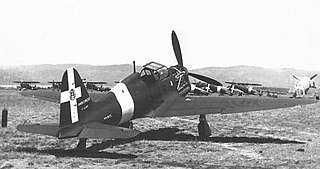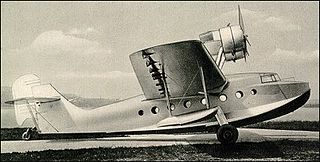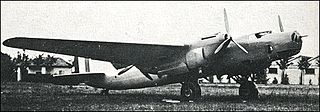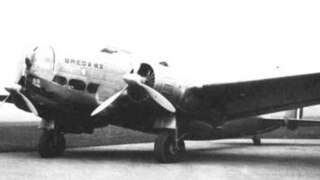
The AUT.18 was a prototype fighter aircraft developed in Italy by Aeronautica Umbra shortly before the outbreak of World War II. It was designed in 1934 by Felice Trojani, who at that time was collaborating with Umberto Nobile on the Arctic flights of the airships Norge and Italia. The aircraft's designation came from initials of the manufacturer, the surname of the designer, and the aircraft's wing area, the sole prototype receiving the serial no. M.M.363.

The Fiat CR.25 was an Italian twin-engine reconnaissance-bomber fighter aircraft which served in small numbers for the Regia Aeronautica during World War II.

The Ambrosini SAI.7 was an Italian racing aircraft flown before World War II that entered production as a military trainer after the war. It was of conventional configuration, constructed of wood, with a tail wheel undercarriage. Power was provided by an air-cooled inverted inline engine, the Alfa-Romeo model 115 with 225 horsepower.
The Ambrosini SAI.2 was a light monoplane built in Italy in 1934. Like the SAI.1, it was designed to participate in the Avioraduno del Littorio rally of 1935. Compared with that aircraft, the SAI.2's wing area was only 1.4 m² (15 ft²) less, but the reduction in drag as a result of the monoplane configuration versus that of a biplane resulted in a top speed 20 km/h (12 mph) higher. Both aircraft used the same engine type.

The Ambrosini SAI.3 was a two-seat Italian touring airplane first flown in 1937. It was a low-wing monoplane with a graceful, elliptical wing, and fixed tailwheel undercarriage. Customers could choose between enclosed or open cockpits, and between an inline Alfa Romeo 115 engine or a radial Fiat A.50. A revised version was marketed as the SAI.3S with a smaller-chord wing and a Siemens-Halske Sh 14 radial engine, this offering far superior performance to the original SAI.3 design.

The Ambrosini SAI.207 was a light fighter interceptor built entirely from wood and developed in Italy during World War II. Powered by a single 750 hp Isotta Fraschini Delta, the SAI.207 enjoyed limited success during evaluation of the 12 pre-production aircraft.

The Breda Ba.25 was an Italian two-seat biplane trainer designed and built by the Breda company. It was the most widely used Italian basic trainer of the 1930s.

The Fiat CR.1 was an Italian biplane fighter aircraft of the 1920s. Of wood-and-fabric construction, it was designed by Celestino Rosatelli, from whom it gained the 'CR' designation. Its most distinctive feature was that the lower wings were longer than the upper ones.

The Caproni Ca.165 was an Italian biplane fighter developed just before World War II, but produced only as a prototype, as the competing Fiat CR.42 Falco was selected for series production.

The SAI-Ambrosini SS.4 was an Italian fighter prototype developed in the late 1930s, featuring a canard-style wing layout and a pusher propeller. Development of the SS.4 was abandoned after the prototype crashed on its second flight.

The Caproni Vizzola F.5 was an Italian fighter aircraft built by Caproni. It was a single-seat, low-wing cantilever monoplane with retractable landing gear.
The Piaggio P.32 was an Italian medium bomber of the late 1930s, produced by Piaggio, and designed by Giovanni Pegna. It was a modern design for its time, but was a failure due to lack of powerplants commensurate with its high wing loading.

The IMAM Ro.51 was an Italian fighter aircraft that first flew in 1937. It was designed for the 1936 new fighter contest for the Regia Aeronautica, with practically all the Italian aircraft builders involved.

The IMAM Ro.57 was an Italian twin-engined, single-seat monoplane fighter of the Regia Aeronautica. Based on a 1939 design by Giovanni Galasso the aircraft did not enter production until 1943.

The Macchi M.C.94 was a 1930s Italian commercial flying boat built by Macchi.

The Nardi FN.305 was an Italian fighter trainer and liaison monoplane developed by the Fratelli Nardi company.

The Fiat B.R. 1/4 was a light bomber series, developed in Italy shortly after World War I.

The Piaggio P.50 was an Italian prototype heavy bomber designed and built by Piaggio for the Regia Aeronautica.

The Piaggio P.111 was an Italian high-altitude research aircraft designed and built by Piaggio for the Regia Aeronautica.

The Breda Ba.82 was an Italian medium bomber prototype of the late 1930s; it was designed and built by the Breda company.



















